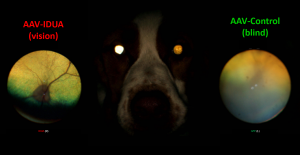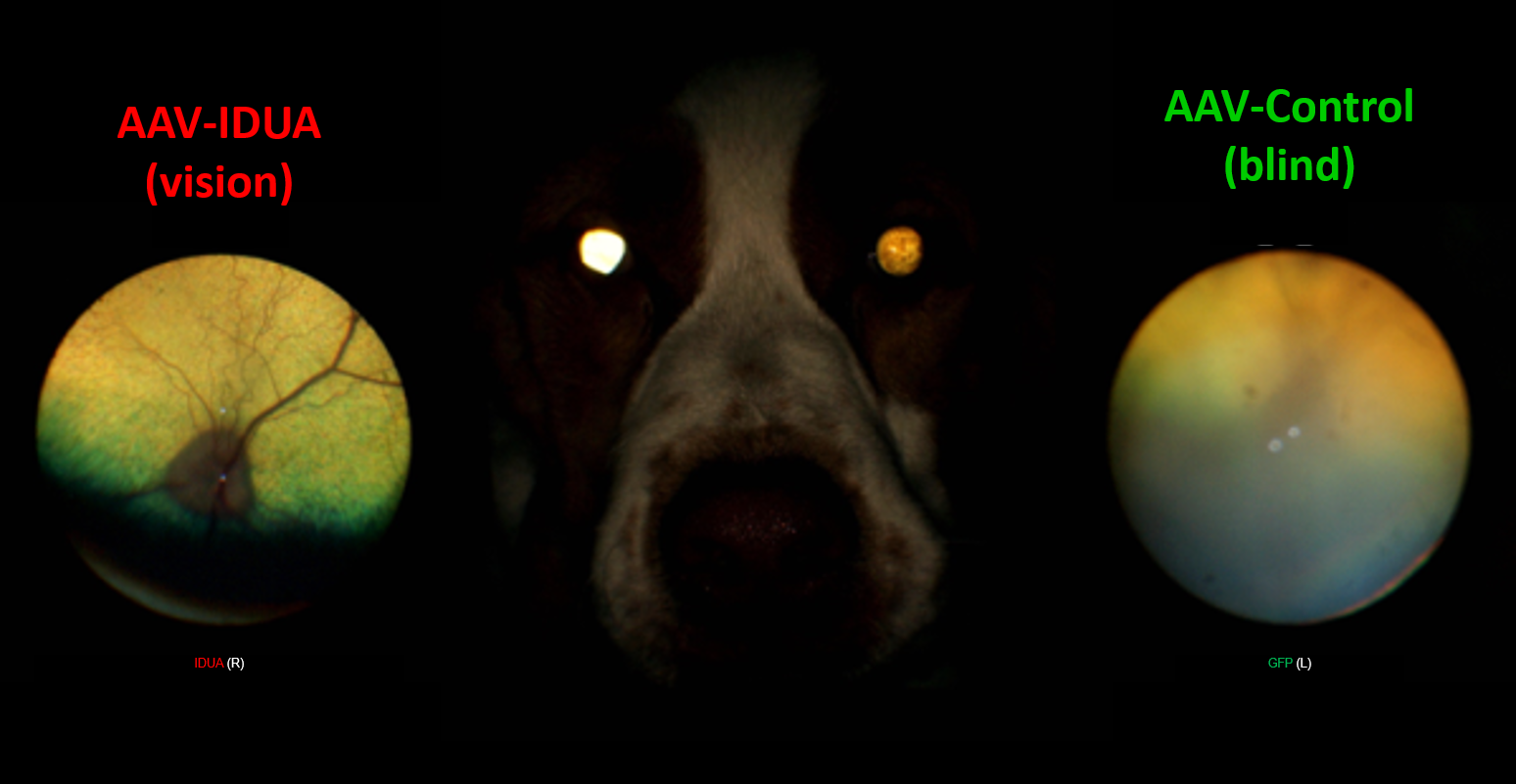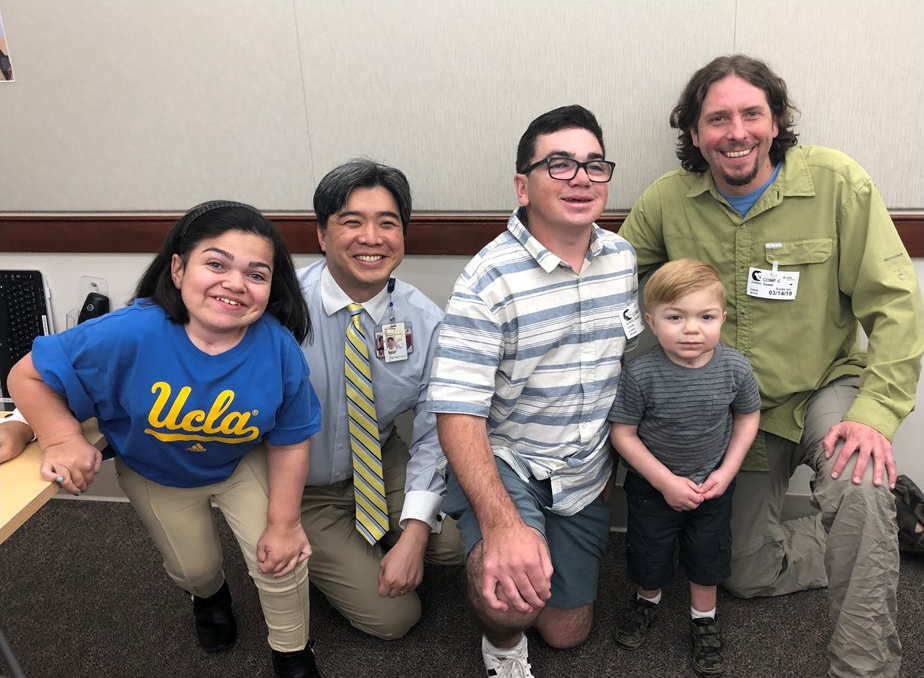Matthew Hirsch, PhD, assistant professor in the UNC Department of Ophthalmology and member of the UNC Gene Therapy Center, hopes to embark on a clinical trial this year to test the first ocular gene therapy that could restore the sight of patients suffering from a rare lysosomal storage disease.

Matthew Hirsch, PhD, assistant professor in the UNC Department of Ophthalmology and member of the UNC Gene Therapy Center, hopes to embark on a clinical trial this year to test the first ocular gene therapy that could restore the sight of patients suffering from a rare lysosomal storage disease.


Matthew Hirsch, PhD, has focused much of his academic career on Mucopolysaccharidosis I (MPS I), a rare genetic disorder that manifests as devastating organ damage. MPS I is caused by alteration in a gene that makes alpha-L-iduronidase (IDUA), an enzyme required to break down glycosaminoglycans (GAGs), or long chains of complex sugar molecules. All current treatments are just partially effective in addressing systemic disease and do not treat vision loss caused by corneal opacity.
Stem cell transplantation as a treatment for MPS I started in the early 90’s which was, in part, pioneered by Dr. Joanne Kurtzburg, the director of Duke’s pediatric blood and marrow transplant program and the Robertson Clinical and Translational Therapy Program at Duke University. The result of Kurtzburg’s efforts demonstrated increased lifespan of MPS I patients, sometimes by decades.
However, all MPS I treatments to date fail to address disease manifestations in compartmentalized organs including mobility, hearing, and vision due to poor transfusion rates. All MPS I patients experience progressive vision loss resulting in blindness and the high rejection rate of corneal transplants in this population discourages the procedure as a clinical standard of care. Therefore, Hirsch and the UNC Gene Therapy Center (GTC) led a collaborative effort with Kurtzberg to improve the life quality of MPS I patients by preventing vision loss and, perhaps, by restoring sight.
The concept behind this new treatment is to use adeno-associated virus (AAV) vectors to deliver cDNA encoding IDUA directly to the human corneal stroma through a process called transduction allowing the cells to express and secrete their own functional IDUA – and the results to date are very promising. The first step was to create the most efficient AAV capsid or “gene delivery truck” for human corneal transduction. In a collaboration with Dr. Aravind Asokan, previously of the UNC GTC and now at Duke, the team rationally designed a chimeric AAV capsid (termed 8G9) that is better than what nature had to offer for robust transduction of the cornea using human cadaver tissue graciously donated by the Miracles in Sight Eye Bank in Winston Salem.
“This unique opportunity to conduct experiments in the target tissue eliminates inter-species translational concerns commonly observed in AAV clinical gene therapy applications,” Hirsch notes.
Once the mechanism of delivery was solved, a safe and effective IDUA genetic cassette was engineered and validated for IDUA production in MPS I patient cells deficient for the enzyme. Supraphysiological IDUA abundance and function were observed without any signs of toxicity. However, the question remained of whether or not IDUA gene complementation in the corneas of MPS I patients would address the progressive vision loss. Like humans, canines also are afflicted by MPS I and lose vision, thereby presenting a model to determine the efficacy of AAV8G9-IDUA corneal gene therapy.
With funding support from the University of Pennsylvania’s Orphan Disease Center and the clinical expertise of Dr. Keiko Miyadera, a veterinary ophthalmologist, Hirsch and colleagues were able to improve MPS I canine vision as early as seven days following a single administration which progressed to near clinical normalcy over approximately a year post-treatment.
“Although we were optimistic that our approach would slow MPS I vision loss, its ability to reverse pre-existing corneal opacity was near miraculous,” Hirsch said.
Continued refinement required dose de-escalation studies demonstrating drug efficacy at a 250-fold lower dose than any FDA approved AAV gene therapy used in the clinic. So far, every dog that has been treated has had restored vision with persistent expression of IDUA. Additional toxicity studies supported by the National MPS Society located in Durham and conducted by Hirsch’s long-term collaborator, Dr. Brian Gilger, at North Carolina State’s College of Veterinary Medicine, demonstrated complete tolerability and durability of AAV8G9-IDUA.
Currently, Hirsch is working with the North Carolina Biotechnology Center and the Research Triangle Institute to put together a pre-Investigational New Drug (pre-IND) application for the continued translation of this technology into a therapy to improve vision in MPS I patients.
“It takes a village to develop a safe and effective drug from an idea through preclinical validation,” Hirsch said. “And in an effort led by the UNC GTC and the Department of Ophthalmology, we have partnered with six institutions in the state of North Carolina alone, highlighting our state’s unique environment for drug development using gene therapy.”
A pre-IND application will be submitted soon and the team hopes to embark on a Phase I clinical trial by the end of this year. Hirsch anticipates that this project will be given a Fast Track designation by the FDA, and the clinical trials initially to be undertaken at UNC’s Kittner Eye Center will be the world’s first AAV gene therapy demonstration in the anterior eye.
Hirsch’s effort to restore sight to patients of this rare disease has been taking place over the past five years, a relatively short time for de novo drug development. The UNC School of Medicine is proud of the progress that Hirsch and his team have made. This work is a prime example of the excellent partnering of basic and clinical sciences that is fostered and thriving in the school.